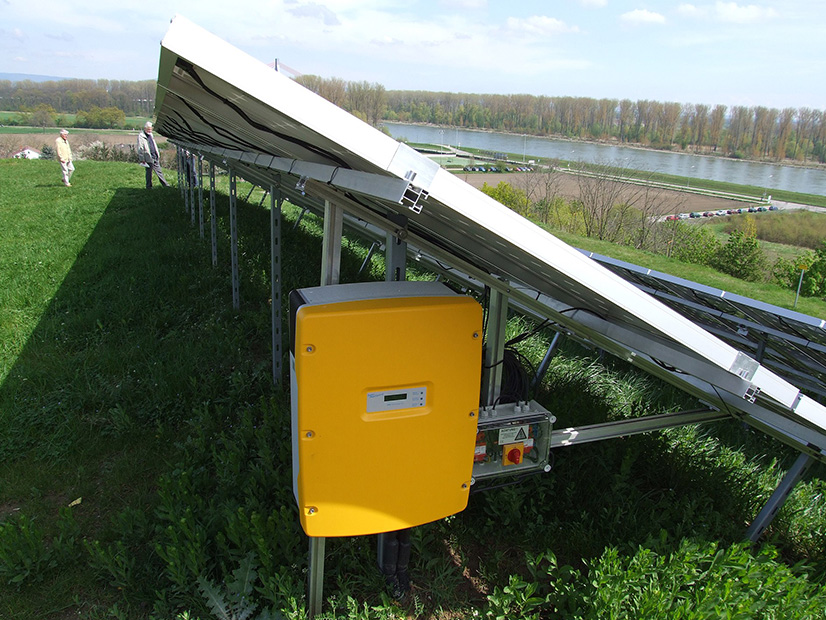
[EDITOR’S NOTE: A previous version of this article made it unclear that PRR-151 has not been fully approved by the NYSRC; the council approved publishing the proposed rule for comment.]
The New York State Reliability Council (NYSRC) has proposed establishing a uniform set of requirements for inverter-based resources (IBRs) over 20 MW to connect to the NYISO grid, leaving the ISO concerned that its generator interconnection queues could become even more clogged.
PRR-151, published March 10, is based on IEEE Standard 2800-2022, itself approved by the Institute of Electrical and Electronics Engineers’ board of directors in February 2022. It would direct NYISO to adapt the IEEE standard’s specifications for IBR performance criteria, databases and model validation methods — among other requirements — for use in its territory.
IBRs in the state would be required to be able to provide dynamic active support services during abnormal voltage or frequency situations, operate in active or reactive power control scenarios, and quickly communicate with NYISO during disturbances. Resource owners would be required submit self-certified compliance verifications to the ISO.
In its posting of the rule, the NYSRC cited the expected increase in the state’s renewable resources and the disturbances in California and Texas during which “IBRs failed to perform reliably, creating system supply deficits.” (See NERC, WECC Warn of Inverter Modeling Gaps and NERC Repeats IBR Warnings After Second Odessa Event.)
It also cited FERC’s Notice of Proposed Rulemaking to direct NERC to develop standards for IBRs (RM22-12). The commission noted IEEE 2800, along with several other related efforts, as “voluntary industry standards.”
“These efforts may enhance the operating performance and control capabilities of IBRs; however, these efforts remain at relatively early stages, do not apply to all relevant IBRs, and require adoption by state or other regulatory authorities,” FERC said. “The proposed directives to NERC to develop new or modify existing reliability standards are intended to complement existing voluntary efforts underway and are not intended to supersede or interfere with these efforts.” (See FERC Addresses IBRs in Multiple Orders.)
Comments on PRR-151 are due April 27.
NYISO, Stakeholders Tepid
The ISO presented the proposed rules to hesitant members of the Transmission Planning Advisory Subcommittee and Electric System Planning Working Group on Friday.
Roger Clayton, chair of the NYSRC’s Reliability Rules Subcommittee, told the groups that PRR-151 was developed because of “the poor reliability performance of like-devices in Texas and California,” and “the cumulative amount of IBRs in NYISO’s interconnection queue … warrants the implementation of IEEE 2800 to govern the interconnection of these devices.”
According to the council’s posting, as of Jan. 5, more than 50,000 MW of IBRs were in NYISO’s queue.
Clayton said the requirements are “for new generators, and the intent is for PRR-151 to not be looking backwards,” noting that they would likely be effective after the current NYISO Class Year.
NYISO had told the council it was concerned that PRR-151 would increase the amount of time required for IBRs to complete interconnection studies; could require lengthy manual and tariff revisions; and did not specify a clear timeline for generator owners to begin demonstrating compliance. Many of these sentiments were shared by stakeholders at the meeting.
Doreen Saia, an attorney with Greenberg Traurig, said developers need to understand how the rules would affect them “because otherwise all we’re going to have an unholy mess on our hands.”
In response to the unease, Chris Wentlent, chair of the NYSRC’s Executive Committee, said PRR-151 “is a draft rule” and that the council’s goal “was to get [PRR-151] to the surface so everyone is paying attention to it,” as well as “allow folks to start commenting.”
Wentlent later promised to consider giving stakeholders an in-depth technical presentation on the proposed rules.
